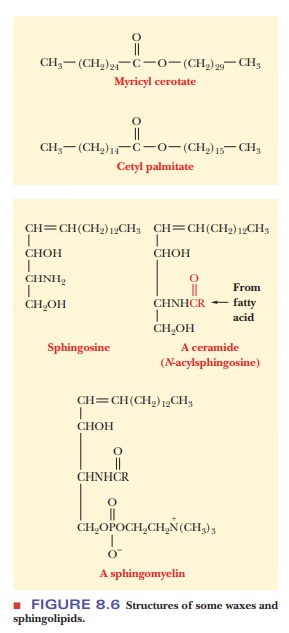Chapter: Biochemistry: Lipids and Proteins Are Associated in Biological Membranes
What are waxes and sphingolipids?
What are waxes and sphingolipids?
Waxes are complex mixtures of
esters of long-chain carboxylic acids and long-chain alcohols. They frequently
serve as protective coatings for both plants and animals. In plants, they coat
stems, leaves, and fruit; in animals, they are found on fur, feathers, and
skin. Myricyl cerotate (Figure 8.6), the principal component of carnauba wax,
is produced by the Brazilian wax palm. Carnauba wax is extensively used in floor
wax and automobile wax. The principal component of spermaceti, a wax produced
by whales, is cetyl palmitate (Figure 8.6). The use of spermaceti as a
component of cosmetics made it one of the most highly prized products of
19th-century whaling efforts.

Sphingolipids do not contain glycerol, but
they do contain the long-chainamino alcohol sphingosine, from which this class
of compounds takes its name (Figure 8.6). Sphingolipids are found in both
plants and animals; they are par-ticularly abundant in the nervous system. The
simplest compounds of this class are the ceramides, which consist of one fatty
acid linked to the amino group of sphingosine by an amide bond (Figure 8.6). In
sphingomyelins, the primary alcohol
group of sphingosine is esterified to phosphoric acid, which, in turn, is
esterified to another amino alcohol, choline (Figure 8.6). Note the structural
similarities between sphingomyelin and other phospholipids. Two long
hydro-carbon chains are attached to a backbone that contains alcohol groups. One
of the alcohol groups of the backbone is esterified to phosphoric acid. A
second alcohol-choline, in this case-is also esterified to the phosphoric acid.
We have already seen that choline occurs in phosphoacylglycerols.
Sphingomyelins are amphipathic; they occur in cell membranes in the nervous
system (see the following Biochemical Connections box).
Related Topics